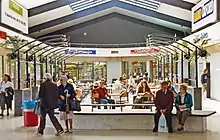Railway refreshment room
A Railway Refreshment Room (RRR) is a catering facility attached to a railway station. They were opened in the 19th century to serve passengers when trains did not convey catering facilities, hence RRRs were opened at stations to not only serve passengers passengers joining but also en-route. RRRs were similar to tearooms, and generally served a variety of hot drinks, pastries, cakes, and light meals. With the introduction of Buffet and Dining cars, their need began to decline. With the replacement of steam locomotives with diesel and electric locomotives that did not need to make servicing stops, the RRRs began to close.

United Kingdom
The first railway refreshment rooms opened at Wolverton in November 1840,[1] a year earlier than those at Swindon.[2] Trains stopped for 10 minutes at the station.[3] In 1849 they used 85 pigs for pork pies.[4] The quality of pork pies, sandwiches and tea later came in for criticism.[5]
At the time of the formation of British Railways in 1948, 595 Railway Refreshment Rooms existed in the United Kingdom.[6][7]
.jpg.webp)
Australia
On the Queensland Railways network, the first RRR opened at Toowoomba station in 1867. By 1915, there were 47.[8]
New Zealand
The first refreshment room was at the country's first station, Christchurch, which opened in 1863.[9]
By 1935 NZR had 4 sit-down dining rooms, 18 stalls and 30 counter refreshment rooms.[10] They included Ohakune , Whangarei, Paekakariki, Marton, Palmerston North, Woodville, Waipukurau, Taihape, Mercer, Frankton, Taumarunui, Putāruru, Hāwera, Kaitoke, Patea, Maungaturoto, Tauranga, Helensville, Paeroa, Masterton, Te Kuiti, Aramoho and Napier.[11] Customer numbers peaked at over 8.5m a year during World War II. Closures then included Marton in 1954, Frankton and Taumarunui in 1975, and Ōamaru in 1980.[10] Cafes remain at some stations, such as National Park,[12] Ohakune,[13] Otorohanga[14] and Wellington.[15]
References
- Buckinghamshire County Archaeological Service. "Wolverton & New Bradwell Historic Town Assessment" (PDF).
- "History: New town built for railway workers". Swindon Advertiser. Retrieved 2021-02-07.
- Lipscomb, George (1847). The History and Antiquities of the County of Buckingham. J. & W. Robins.
- HEAD, Sir Francis Bond (1849). Stokers and Pokers: or, the London and North-Western Railway, the Electric Telegraph and the Railway Clearing House. By the author of “Bubbles from the Brunnen of Nassau” [Sir F.B. Head]. Third edition. John Murray (printed by William Clowers and Sons).
- "How British Rail limited the butter on its sandwiches, and other Station Stories". National Railway Museum blog. Retrieved 2021-02-07.
- Railway Catering The Railway Magazine issue 577 September 1948 page 283
- Our History Rail Gourmet
- Railway refreshment rooms Queensland Historical Atlas
- "SUMMARY OF INTELLIGENCE FOR THE MONTH ENDING FEBRUARY 13, FOR TRANSMISSION TO ENGLAND. LYTTELTON TIMES". paperspast.natlib.govt.nz. 13 Feb 1864. Retrieved 2021-02-07.
- "Stations and refreshment rooms". teara.govt.nz (in Maori). 11 Mar 2016. Retrieved 2021-02-07.
- "NZR crockery | Westport Railway Preservation Society". Retrieved 2021-02-07.
- "The Station Café, Bar and Restaurant". www.thestationcafe.co.nz. Retrieved 2021-02-07.
- "The Craft Haus". www.visitruapehu.com. Retrieved 2021-02-07.
- "Get in contact with us". Origin Coffee Company. Retrieved 2021-02-07.
- "Trax Bar & Cafe". Retrieved 2021-02-07.